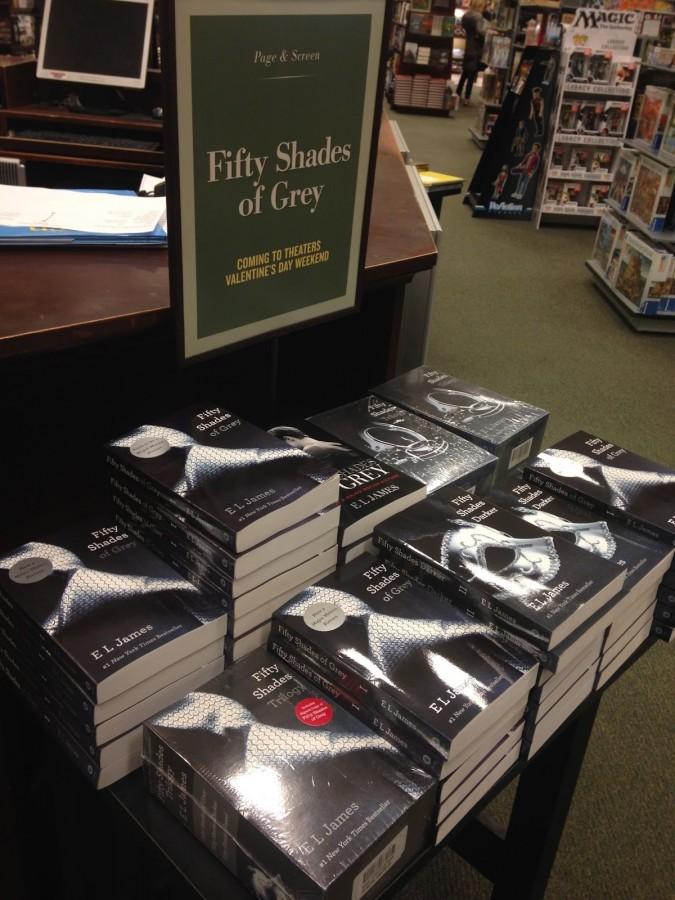50 Shades of Rape? Film, novels stir controversy
The movie adaptation of the best-selling novel came out on Feb. 13, but since has stirred controversy over the abusive relationship between Ana and Christian.
February 24, 2015
E.L. James’ 50 Shades of Grey has raised controversy over its sexual content and portrayal of BDSM relationships since its publication in 2011 and theatrical release Feb. 13. BDSM relationships refer to bondage, discipline, domination, submission, sadism and masochism between consenting adults.
The trilogy and upcoming film features Anastasia Steele (Dakota Johnson, 21 Jump Street), a college student who falls for billionaire Christian Grey (Jamie Dornan, Once Upon a Time). The series follows her relationship with him, focusing particularly on their sexual activities.
Its journey from e-book to anticipated premiere was unexpected and head-turning. It began as Twilight fan fiction. However, James changed the work’s name to 50 Shades and its location to a personal blog, then opted to repurpose her fan fiction as original novels. 50 Shades quickly became a bestselling series, shocking the world with its bold approach to a side of sex previously shaded with obscurity.
According to USA Today’s list of 100 bestselling books of 2012, 50 Shades of Grey topped the list, with its two sequels boasting third and fourth. Suzanne Collin’s Hunger Games trilogy sported second, fifth and sixth on the list.
Criticism of the series’ blatantly erotic material skyrocketed along with sales. Anger over the content and its availability to the general public has led schools and public libraries across the country to ban the series.
According to American Libraries Association’s 2013 Report, 50 Shades was fourth on the Top 10 List of Frequently Challenged Books.
Some are concerned about the repercussions the book’s wide influence will have on younger readers and viewers. Aside from being the dominant in their sexual relationship, Grey quickly becomes deeply involved in Steele’s life and career, insisting on her signing a contract that dictates with whom she can interact, how much she can eat, how much she must exercise and how much sleep she is required to get.
“The movie and book both show a weird trend in society where young people are being convinced that a relationship is fine even if one person is constantly belittled and abused by the other,” senior Savannah Chapa said. “It basically promotes obsessive and abusive ‘love.’”
Despite the controversy and subject material, many teens have fallen for the popular trilogy. From downloading the pdf version or reading hard copies to getting tickets for the premiere, the franchise is inadvertently attracting fans of a completely different age category than James may have intended.
“I read it on a flight to California because our flight was late and the books were there, so I was like, ‘Why not?’” senior Tiffany Russo said.
Why teens are drawn to these subjects at all is a completely different matter and is possibly even more concerning.
“At times, people tend to become interested in things they are told are not appropriate, and it’s just a natural human tendency to be curious about something that’s forbidden,” AP Psychology teacher Katelyn McMahon said.
However, this may not be teens’ fault. Adolescents are curious about sexuality, and 50 Shades explores a side of sexual relationships that is often neglected and sometimes even maligned in media.
“The trailers make the movie seem interesting, and Christian Grey’s personality is very magnetic,” senior Avinaash Sandhu said.
Stores try to follow this trend, resulting in teenage-targeted shops like Icing selling glittery wall hangings with Grey’s quotes and handcuff bracelets.
The film industry has followed suit, adjusting restricted movies in order to make them available to teens. In the last 10 years, 75 films were rated NC-17 upon the end of filming. However, 63 of those were dropped to an R rating by their theatrical release.
According to the Motion Picture Association of America website, R-rated films contain some adult material, where it’s suggested that parents learn about the film before taking their young children to see the movie. NC-17 movies are marked as clearly adult, where children 17 and under are not permitted.
Most would agree that 50 Shades is clearly adult. However, the film is rated R, which allows for an unintentionally younger audience, as R-ratings have come to imply that kids under the age of 17 will be able to see the movie as long as they know someone who can get them in.
“I think they should rate it NC-17 because people are going to sneak in, and I don’t think that younger children can handle it,” Russo said. “The book was intense and I needed a break after reading some parts. Just to buy it, you need to be 18 years old, and they ask for your ID.”
Suffice to say, the books’ material is eyebrow-raising and its screen sister is no different. Whether students choose to read and see the film is their choice alone, but it’s important to remember that a book is never just a book. While some may see the 50 Shades franchise as laughably awkward, its topics can leave lasting impressions on an audience that still has to get permission slips signed to participate in sex ed.


